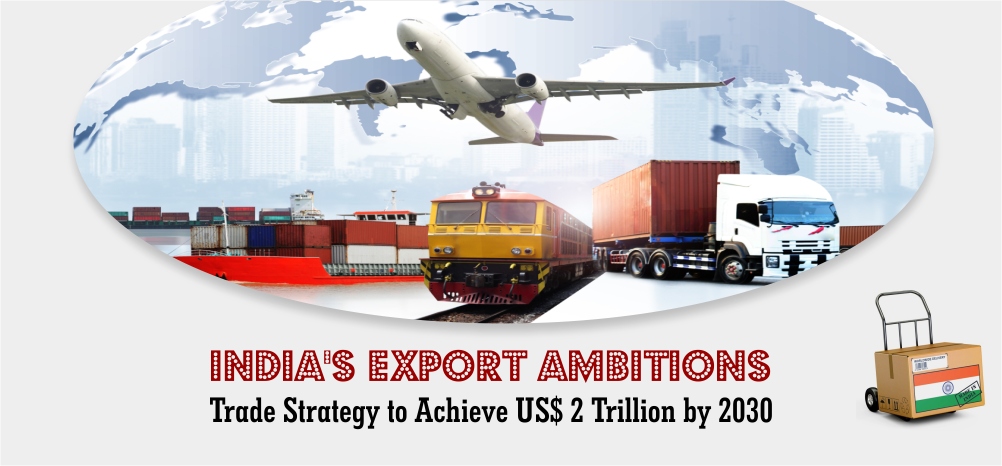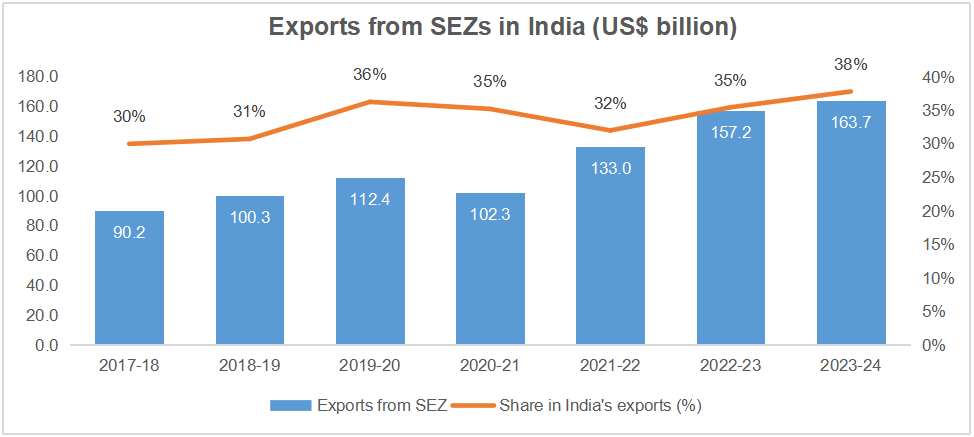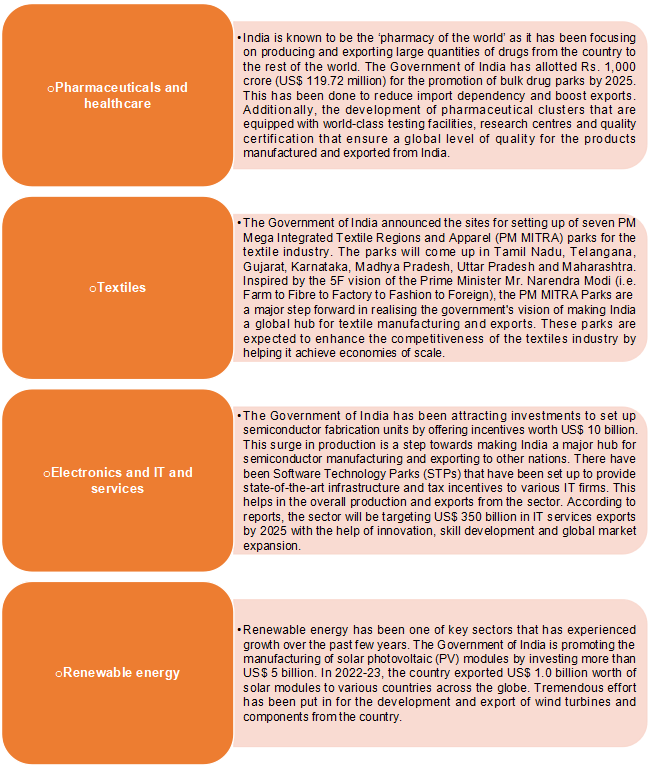RECENT CASE STUDIES
India's Export Ambitions: Trade Strategy to Achieve US$ 2 Trillion by 2030
Last updated: Aug, 2024
India has been one of the fastest growing economies in the world and has demonstrated remarkable flexibility and adaptability. During the past few decades, India has established a firm position in the global economy by leveraging its demographic benefits, thereby boosting its entrepreneurship culture and technological growth. The country has successfully transitioned from being an agriculture-driven economy to an industrial and service-oriented one, displaying growth in several key sectors.
India’s annual Gross Domestic Product (GDP) growth rate has been at a healthy high single digit, driven by robust domestic demand, expanding middle-class population and a dynamic service sector. The COVID-19 pandemic had presented some unfortunate challenges to the overall economy, resulting in a contraction in 2020. However, prompt government actions and implementation of policies to reduce the impact of the pandemic led to a steady recovery and pushed the economy to greater heights.
As India has transitioned to being an industrial economy, exports play a crucial role in the overall growth as it contributes massively to the GDP of the country. According to the World Bank, India’s exports of goods and services as a percentage of GDP stood at 21.9% in 2023 as compared to 13% in 2000. The enhancement of the export sector improves foreign exchange reserves, stabilises the national currency and aids the financial health of the country. Additional benefits of growing exports include, employment opportunities, promotion of industrial development and technological advancements.
Achieving a target of US$ 2 trillion in exports holds great significance for India in terms of the social and economic aspect. The objective of this goal is not just about the US$ 2 trillion value but also about the overall growth of the country in being the global force dominating exports worldwide. In this case study, we will understand the strategies adopted to meet the ambitious target by 2030, along with the various challenges that could be faced in this journey.
Strategies to achieve US$ 2 trillion export target
India’s strategy to achieve the US$ 2 trillion target by 2030 revolves around adapting a versatile approach that involves government policy initiatives, infrastructure enhancement and a focus on the key sectors that drive these exports. Below, we have outlined the key strategies that can help India achieve this ambitious target.
- Government policy initiatives
Collaboration and support of the government is essential to achieve the ambitious target of US$ 2 trillion in exports. The government has taken tremendous efforts to enhance exports from the country and reduce import dependency. Some of the initiatives have been mentioned here:
- Make in India
- The Make in India programme was launched in 2014 with the aim of transforming India into a globally recognised manufacturing hub. The introduction of this policy increased the domestic and foreign investment in the manufacturing sector. As per reports, the manufacturing sector contributed 16-17% to GDP in the pre-pandemic period and is forecast to reach 25% in 2025. This initiative also aims at creating jobs in the country. In 2014, the manufacturing sector employed over 27.3 million professionals. With the help of the Make in India initiative, it is anticipated to create 100 million jobs by 2022.
- Make in India initiative has key components such as sector-specific targets, simplification of regulatory norms, and the promotion of investment in India. The Government of India launched the Goods and Services Tax (GST) in 2017, as part of the regulatory norms easing. By clubbing various taxes for suppliers and manufacturers into one, this initiative helped to simplify the tax structure, thereby reducing tax complications and enhancing transparency in the system. The government has a sector-specific approach towards sectors that contribute largely to exports, as part of this initiative. The automotive sector was the focus with a target to achieve production of 30 million units by 2026. Similarly, the electronics sector was given importance as the target was to reach production of US$ 190 billion worth of mobile phones and components by 2025. By aiding the production expansion, leading to higher exports from the country, the Make in India initiative has boosted investment in India.
- Atmanirbhar Bharat (Self-Reliant India)
- The Atmanirbhar Bharat programme was launched by the Government of India in 2020. The primary aim of this programme was to make India a self-sufficient economy by boosting local manufacturing and increasing exports, while reducing dependency on imports.
- The key components of this programme included the Production Linked Incentive (PLI) schemes, strengthening of the Micro, Small, Medium Enterprises (MSME) sector and introduction of policy reforms by the government. As part of the PLI schemes, the government allocated ~US$ 27 billion across 13 key sectors between 2020 and 2025. The key sectors included the following: Electronics – The target production in this sector was set at US$ 153 billion and generating employment to approximately 1 million professionals. Pharmaceuticals – The focus was laid on production of high-value drugs and Active Pharmaceutical Ingredients (APIs). Automobiles – The goal for this sector was promoting the manufacturing of Electric Vehicles (EVs) and various other components of the automotive sector. Strengthening of the MSME sector was another key component of this programme. This was done through the launch of the Emergency Credit Line Guarantee Scheme (ECLGS) with a budget of US$ 40 billion to support companies operating in this category that were majorly affected by the COVID-19 pandemic. Lastly, there are policy reforms such as the implementation of National Infrastructure Pipeline (NIP) with a projected investment of ~US$ 1.4 trillion between 2020 and 2025 to develop critical infrastructure aiding exports.
- PLI Schemes
- As part of the Union Budget 2021-22, the Finance Minister of India, Ms. Nirmala Sitharaman, announced the outlay of Rs. 1.97 lakh crore (US$ 23.58 billion) for the PLI schemes for 13 sectors. PLI schemes are a foundation for the Atmanirbhar Bharat programme. These schemes are designed to boost the domestic manufacturing of goods and provide financial incentives to various sectors based on the production and export performance. It aims to enhance manufacturing capabilities, increase export competitiveness and thereby attract more global investments in the country.
- As part of the PLI scheme, 13 sectors were shortlisted, of which three sectors – electronics and IT hardware, pharmaceuticals, and automobiles and auto components – had significant outlays and production plans. The electronics sector, through PLI schemes, is expected to generate incremental production of ~US$ 153 billion and exports worth ~US$ 100 billion by 2025. Pharmaceuticals is the sector that focuses on production of high-value drugs and APIs, with an outlay of ~US$ 2 billion. Automobiles and auto components are the key focus as the PLI schemes support the manufacturing of EVs in the country and their components, providing an outlay of ~US$ 7.6 billion, thereby enhancing the production and export capacity of India.
- EXIM Bank and SIDBI Bank
- The Export-Import Bank of India (EXIM Bank) and other financial institutions such as Small Industries Development Bank of India (SIDBI) play an important role in promoting the exports from the country as it supports exporters by providing financial products and services that serve the specific needs of the exporters. EXIM Bank provides lines of credit to overseas buyers to purchase goods and services from India. This in turn facilitates larger transactions and entry into news markets by providing financial support to buyers and exporters. Similarly, SIDBI helps in the promotion of exports by offering various schemes to the MSMEs to access international markets.
- Infrastructure development
For boosting exports from India, infrastructure development is quite crucial, reduces logistical costs, enhances supply chains, and ensures timely delivery of goods. Infrastructure development includes improved transportation networks such as highways, railways, and ports, which aid in the smooth and fast movement of products to the international markets. Below are some of the infrastructure developments that the country has implemented to boost the production and export performance of India:
- Enhancement of ports and logistics infrastructure
Efficient port and logistics infrastructure are vital for seamless export functioning. To reduce costs and improve efficiency, India focuses on enhancing and modernising its logistics network. Modernisation of major ports such as the Jawaharlal Nehru Port Trust (JNPT), Mumbai Port Trust (MPT) and the Chennai Port are part of the expansion activities have been conducted. Initiatives such as the Sagarmala Programme have been set up that aims to modernise the ports, promote development, and enhance connectivity with an investment of US$ 123 billion, thereby aiding exports from the country.
Similarly, tremendous effort has been made in the development of inland waterways, logistics parks and warehousing facilities. With significant investments in NW-1 (Ganga River), NW-2 (Brahmaputra River) and NW-3 (West Coastal Canal) there has been development of 111 national waterways, which has taken place. With an estimated investment of ~US$ 2 billion to reduce logistics costs and shipment times, 35 multi-modal logistics parks have been established. Moreover, US$ 1 billion has been invested to develop the cold chain network, specifically for perishable goods.
- Development of Special Economic Zones (SEZs)
By providing a favourable environment for businesses to function, SEZs have been playing a critical role in the enhancement and boosting of exports. Enhancing the economic activity, promoting exports of goods and services from the country, increasing the foreign and domestic investment, and creating more employment opportunities beside the development of infrastructure facilities is the main purpose of SEZ.
Some of the key features of the SEZ include tax incentives, infrastructural support, and ease of doing business. There are 100% income tax exemptions on export income for SEZ units for the first five years, 50% in the next five years, and 50% for another five years of the ploughed-back export profit. Development of infrastructure includes providing reliable power supply, water, and transportation facilities. Lastly, the implementation of single-window clearances for various regulatory approvals aids businesses in smooth functioning.

Source: SEZ India
Exports from SEZs in India have shown tremendous growth from 2017 to 2023. In 2017-18, exports from SEZs stood at US$ 90.2 billion and grew to US$ 163.7 billion in 2023-24. Similarly, the share of SEZs in the overall exports from India has growth from 30% in 2017-18 to 38% in 2023-24. Overall, exports grew at a CAGR of 23% over the past 18 years (2005-06 to 2023-24), and major export destinations include the US, UAE, Australia, the UK, and Singapore.
- Sectoral strategies
To achieve the ambitious goal of US$ 2 trillion exports by 2030, it is vital to focus on certain sectors that possess significant export potential and drive the exports of India. Below are some of the sectors that promote trade:

- Investment in digital infrastructure
Investment in digital infrastructure is crucial for boosting exports from India as it modernises and streamlines the trade operations from the country, making them more efficient and competitive. Through enhanced digital infrastructure, exporters experience better connectivity and communication, which aids them to access global markets more seamlessly.
The key components of enhancing digital infrastructure include the introduction of e-governance platforms, trade portals and implementation of blockchain technology. E-governance platforms such as the Indian Customs Electronic Gateway provide e-filing services to trade and cargo carriers that offer 24x7 access to customs services. Similarly, the introduction of trade portals such as the Directorate General of Foreign Trade (DGFT) offers a one-stop destination for all trade-related information, access to market data and important documentations of export-import. Lastly, blockchain technology has been playing a major role in the enhancement of exports from the country. Through smart contracts, which automatically verify the terms of the trade agreement, which help in reducing the risk of errors and frauds, blockchain technology can streamline the documentation process. This technology also enables real-time tracking of goods, which improves the transparency and accuracy of information between the exporters and importers. Furthermore, the blockchain’s immutable ledger can provide verifiable proof of origin, proving to be majorly beneficial for sectors such as agriculture and pharmaceuticals, where the authenticity of products is critical. Adoption of blockchain technology can further improve the trade scenario in India.




